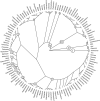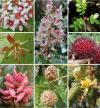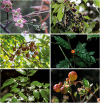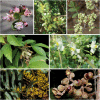An updated infra-familial classification of Sapindaceae based on targeted enrichment data
- PMID: 34219219
- PMCID: PMC8361682
- DOI: 10.1002/ajb2.1693
An updated infra-familial classification of Sapindaceae based on targeted enrichment data
Erratum in
-
Corrigendum.Am J Bot. 2022 Aug;109(8):1326-1327. doi: 10.1002/ajb2.16049. Epub 2022 Aug 26. Am J Bot. 2022. PMID: 36017873 Free PMC article. No abstract available.
Abstract
Premise: The economically important, cosmopolitan soapberry family (Sapindaceae) comprises ca. 1900 species in 144 genera. Since the seminal work of Radlkofer, several authors have attempted to overcome challenges presented by the family's complex infra-familial classification. With the advent of molecular systematics, revisions of the various proposed groupings have provided significant momentum, but we still lack a formal classification system rooted in an evolutionary framework.
Methods: Nuclear DNA sequence data were generated for 123 genera (86%) of Sapindaceae using target sequence capture with the Angiosperms353 universal probe set. HybPiper was used to produce aligned DNA matrices. Phylogenetic inferences were obtained using coalescence-based and concatenated methods. The clades recovered are discussed in light of both benchmark studies to identify synapomorphies and distributional evidence to underpin an updated infra-familial classification.
Key results: Coalescence-based and concatenated phylogenetic trees had identical topologies and node support, except for the placement of Melicoccus bijugatus Jacq. Twenty-one clades were recovered, which serve as the basis for a revised infra-familial classification.
Conclusions: Twenty tribes are recognized in four subfamilies: two tribes in Hippocastanoideae, two in Dodonaeoideae, and 16 in Sapindoideae (no tribes are recognized in the monotypic subfamily Xanthoceratoideae). Within Sapindoideae, six new tribes are described: Blomieae Buerki & Callm.; Guindilieae Buerki, Callm. & Acev.-Rodr.; Haplocoeleae Buerki & Callm.; Stadmanieae Buerki & Callm.; Tristiropsideae Buerki & Callm.; and Ungnadieae Buerki & Callm. This updated classification provides a backbone for further research and conservation efforts on this family.
Keywords: Sapindaceae; Sapindales; biogeography; infrafamilial classification; new tribes; targeted enrichment; taxonomy.
© 2021 The Authors. American Journal of Botany published by Wiley Periodicals LLC on behalf of Botanical Society of America.
Figures




References
-
- Acevedo‐Rodríguez, P.2003. Melicocceae (Sapindaceae): Melicoccus and Talisia . InFlora neotropica monograph, vol. 87, 1–179. New York Botanical Garden Press, Bronx, NY, USA.
-
- Acevedo‐Rodríguez, P.2009. Neotropical Sapindaceae. InMilliken W., Klitgård B., and Baracat A.. Neotropike [eds.], Interactive key and information resources for flowering plants of the Neotropics. Website: www.kew.org/neotropikey.
-
- Acevedo‐Rodríguez, P., P. van Welzen , Adema F., and R. W. J. M. van der Ham . 2011. Sapindaceae. InKubitzki K. [ed.], Flowering plants. Eudicots. The families and genera of vascular plants, vol. 10. Springer, Berlin, Germany.
-
- Acevedo‐Rodríguez, P., Wurdack K. J., Ferrucci M. S., Johnson G., Dias P., Coelho R. G., Somner G. V., Steinmann V. W., Zimmer E. A., and Strong M. T.. 2017. Generic relationships and classification of tribe Paullinieae (Sapindaceae) with a new concept of supertribe Paulliniodae. Systematic Botany 42: 96–114.
Publication types
MeSH terms
LinkOut - more resources
Full Text Sources

